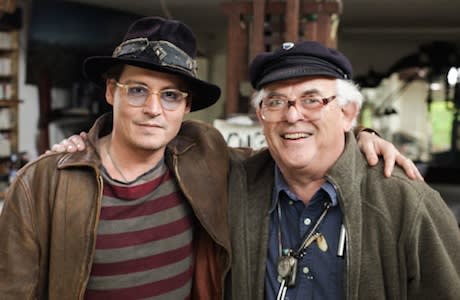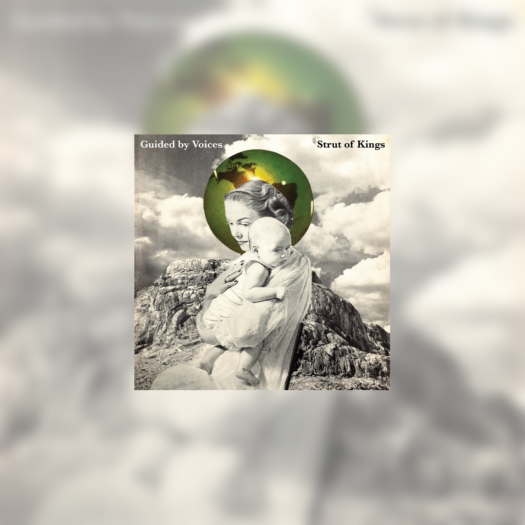When celebrities get together to celebrate one of their own, it can often be a self-congratulatory softball fest. Simply admiring the work of a great artist is all fine and dandy, but a documentary needs to be more than that; it needs to probe the subject, lest it devolve into nothing more than lip service.
For No Good Reason nearly falls into that trap with host Johnny Depp, whose presence makes complete sense, but adds nothing of substance to this look at the art, activism and famous professional associations of Ralph Stedman. The reigning king of marquee caricatures generally stands around looking ridiculously in his self-consciously hip outfit, smoking cigarettes, drinking coffee and fawning over Stedman's work and explorative methods of creating art.
Luckily for director Charlie Paul, Ralph Stedman is a passionate, engaging and very introspective fellow, and he has no problem taking the reins for his inquisition. Since his fame is inextricably linked to that of incisive mad bastard writer Hunter S. Thompson, it's not surprising that Paul skims over Stedman's formative years, treating his time being bullied in a religious school as a preamble to the main event: the meeting of two future counterculture icons.
One of the big selling points of For No Good Reason for many will be the inclusion of archival footage of a young Stedman and Thompson together at the Kentucky Derby to support the lucid anecdotes a modern day Stedman recounts for the camera and our audience avatar, a plainclothes Jack Sparrow. While not exclusively tied to the intuitive artist's work with his partner-in-gonzo, their relationship forms the documentary's narrative spine.
As interesting and illuminating as that side of Stedman's life is, the time spent on it is a bit disproportionate to the subject of Stedman's activism, which is ostensibly the main purpose of the film. His brand of political and social outrage does receive a great deal of attention from Paul, but the director (a big Terry Gilliam fan, judging by the heavy use of slightly surreal stylization in putting this documentary together) is more interested in exploring the visual sensibilities of Stedman's work than their philosophical implications.
Granted, it's great to see so much of Stedman's art in one place and observing his chaos-interpreting creative process is a cherished opportunity. Still, to not dig deeper with a subject so obviously willing and eager to ask himself tough questions regarding the function and futility of his ambitious idealism, and to speak so honestly and critically about life in general, is a missed opportunity.
(Sony)For No Good Reason nearly falls into that trap with host Johnny Depp, whose presence makes complete sense, but adds nothing of substance to this look at the art, activism and famous professional associations of Ralph Stedman. The reigning king of marquee caricatures generally stands around looking ridiculously in his self-consciously hip outfit, smoking cigarettes, drinking coffee and fawning over Stedman's work and explorative methods of creating art.
Luckily for director Charlie Paul, Ralph Stedman is a passionate, engaging and very introspective fellow, and he has no problem taking the reins for his inquisition. Since his fame is inextricably linked to that of incisive mad bastard writer Hunter S. Thompson, it's not surprising that Paul skims over Stedman's formative years, treating his time being bullied in a religious school as a preamble to the main event: the meeting of two future counterculture icons.
One of the big selling points of For No Good Reason for many will be the inclusion of archival footage of a young Stedman and Thompson together at the Kentucky Derby to support the lucid anecdotes a modern day Stedman recounts for the camera and our audience avatar, a plainclothes Jack Sparrow. While not exclusively tied to the intuitive artist's work with his partner-in-gonzo, their relationship forms the documentary's narrative spine.
As interesting and illuminating as that side of Stedman's life is, the time spent on it is a bit disproportionate to the subject of Stedman's activism, which is ostensibly the main purpose of the film. His brand of political and social outrage does receive a great deal of attention from Paul, but the director (a big Terry Gilliam fan, judging by the heavy use of slightly surreal stylization in putting this documentary together) is more interested in exploring the visual sensibilities of Stedman's work than their philosophical implications.
Granted, it's great to see so much of Stedman's art in one place and observing his chaos-interpreting creative process is a cherished opportunity. Still, to not dig deeper with a subject so obviously willing and eager to ask himself tough questions regarding the function and futility of his ambitious idealism, and to speak so honestly and critically about life in general, is a missed opportunity.




